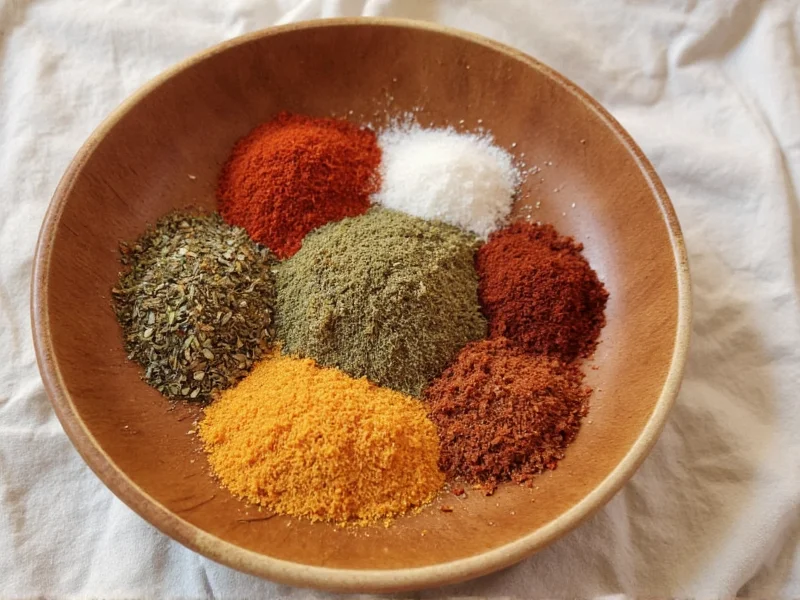Making your own Italian seasoning blend offers superior flavor, freshness, and customization compared to commercial products. Most store-bought versions contain anti-caking agents and inconsistent herb ratios that compromise authentic Italian cuisine flavor profiles. When you create a homemade Italian seasoning recipe from scratch, you control the quality, freshness, and balance of each component herb.
Why Make Your Own Italian Seasoning?
The primary advantage of a DIY Italian herb blend is ingredient quality. Commercial blends often use older, less potent herbs to reduce costs. Freshly mixed seasoning from high-quality dried herbs delivers noticeably brighter flavors. You can also adjust proportions to match regional Italian cooking styles—whether you prefer the robust herb profile of Southern Italy or the more subtle Northern Italian approach.
Essential Ingredients and Their Roles
Understanding each herb's contribution helps you perfect your Italian seasoning mix proportions. The classic combination includes:
| Herb | Flavor Profile | Traditional Italian Use |
|---|---|---|
| Dried Basil | Sweet, slightly peppery | Tomato sauces, pesto, Caprese dishes |
| Dried Oregano | Earthy, slightly bitter | Pizza, tomato-based sauces, grilled meats |
| Dried Thyme | Subtle lemon notes, earthy | Stews, roasted vegetables, braises |
| Dried Rosemary | Pine-like, robust | Lamb, roasted potatoes, focaccia |
| Dried Marjoram | Sweeter, milder than oregano | Egg dishes, light sauces, poultry |
| Garlic Powder | Savory, umami depth | Almost all savory Italian dishes |
Step-by-Step Preparation Guide
Follow these steps for the perfect make your own Italian spice blend:
- Measure ingredients using the standard ratio: 2 parts each of basil, oregano, thyme, rosemary, and marjoram to 1 part garlic powder
- Use a small bowl for mixing—glass or ceramic works best to avoid flavor absorption
- Whisk thoroughly for at least 60 seconds to ensure even distribution
- Test flavor by sprinkling a small amount on olive oil-dampened bread
- Adjust proportions if needed—add more oregano for pizza sauce, more basil for tomato dishes
- Transfer immediately to an airtight container to preserve freshness
Proper Storage Methods
Maximize shelf life of your storing homemade Italian seasoning with these techniques:
- Use dark glass jars with tight-sealing lids to protect from light and moisture
- Store in a cool, dark pantry away from heat sources (not above the stove)
- Label with creation date—properly stored blend remains potent for 6-8 months
- Never store near dishwasher steam or refrigerator condensation
- Use a dedicated spice spoon to prevent moisture contamination
Usage Suggestions and Pairing Ideas
Apply your authentic Italian herb mixture effectively with these professional tips:
- Add to tomato sauces during the last 10 minutes of cooking to preserve volatile oils
- Mix with olive oil for authentic Italian-style bread dipping
- Rub onto chicken or fish before roasting for Mediterranean flavor
- Stir into meatloaf or meatball mixtures for depth of flavor
- Sprinkle over roasted vegetables during the last 5 minutes of cooking
- Combine with breadcrumbs for Italian-style cutlet coatings
Variations for Different Preferences
Customize your customizing Italian seasoning to taste based on dietary needs or regional preferences:
- Low-sodium version: Omit salt (many commercial blends add salt) and increase herb quantities by 25%
- Extra robust blend: Double the rosemary and add 1 teaspoon red pepper flakes
- Milder version: Replace half the oregano with additional marjoram
- Fresh herb adaptation: Use triple the amount of fresh herbs if making immediately before cooking
- Regional variations: Increase basil for Roman dishes, oregano for Neapolitan pizza, rosemary for Tuscan recipes
Troubleshooting Common Issues
Solve problems with your Italian seasoning substitute ingredients preparation:
- Flavor too weak? Herbs may be old—replace with fresher dried herbs (check for vibrant color and strong aroma)
- Bitter aftertaste? Reduce rosemary proportion (it's potent) and increase marjoram
- Clumping in container? Add 1-2 uncooked rice grains to absorb moisture
- Not authentic tasting? Ensure you're using dried—not fresh—herbs for proper flavor concentration
- Flavor fades quickly? Store in smaller containers to minimize air exposure when opened
What's the difference between Italian seasoning and herbes de Provence?
Italian seasoning typically features basil, oregano, rosemary, thyme, and marjoram with garlic notes, while herbes de Provence contains lavender, savory, fennel, and sometimes thyme without garlic elements. The French blend has floral notes from lavender that Italian seasoning lacks.
Can I substitute individual herbs for Italian seasoning?
Yes—for each teaspoon of Italian seasoning, use 1/4 teaspoon each of dried basil, oregano, thyme, and rosemary. This Italian seasoning substitute ingredients approach works well when you need just a small amount for a recipe.
How long does homemade Italian seasoning last?
Properly stored in an airtight container away from light and moisture, your storing homemade Italian seasoning blend maintains optimal flavor for 6-8 months. After this period, the herbs gradually lose potency but remain safe to use.
Why does my homemade blend taste different from store-bought?
Commercial blends often contain anti-caking agents and salt, plus inconsistent herb ratios. Your authentic Italian herb mixture lacks these additives, resulting in a cleaner, more vibrant flavor profile that better represents traditional Italian cooking.
Can I make Italian seasoning without garlic powder?
Absolutely—many traditional Italian cooks prefer blends without garlic. Simply omit the garlic powder and increase the other herbs proportionally. This customizing Italian seasoning to taste creates a more versatile base that works across various dishes.











 浙公网安备
33010002000092号
浙公网安备
33010002000092号 浙B2-20120091-4
浙B2-20120091-4